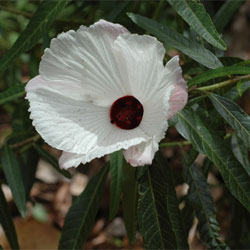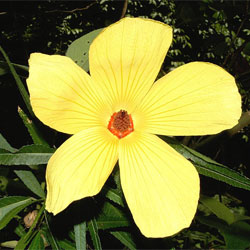Hibiscus heterophyllus
 |
 |
Rosella, Native Sorrel
Hibiscus is a widespread genus of the family Malvaceae, consisting of 250 species, ranging from tropical to temperate regions. Of these species, 35 are native to Australia, and are largely restricted to the East Coast.
 Hibiscus
heterophyllus, with its profusion of showy flowers is an asset to any garden,
and its value is not restricted to its beauty. This tall, fast growing shrub
produces an abundance of flowers and edible fruits, attracting many native birds
and insects to the garden. It is particularly attractive to lorikeets, honeyeaters
and butterflies.
Hibiscus
heterophyllus, with its profusion of showy flowers is an asset to any garden,
and its value is not restricted to its beauty. This tall, fast growing shrub
produces an abundance of flowers and edible fruits, attracting many native birds
and insects to the garden. It is particularly attractive to lorikeets, honeyeaters
and butterflies.
H. heterophyllus has a natural range from the Lockhart River at the very tip of Queensland, down through eastern and central New South Wales, preferring warm, moist environments. While the natural population doesn't venture further south, it has been successfully cultivated in Canberra, and as far south as Melbourne.
The species is frost tolerant, however in these southern areas prone to frosts, the plants will need extra protection. This may mean growing against a wall or fence, or in a pot so that the plant can be moved to shelter or indoors during the cooler periods.
There is much natural variation H. heterophyllus flowers, largely a result of the environment within which it grows. For example, in northern Queensland the flowers tend to be a bright yellow colour and begin in June, while further south they tend to be white and begin in December. H. heterophyllus grows as a rounded shrub, sometimes up to 6m but usually 1.8m. In time, the shrub may become sparse which can be overcome by regular tip pruning from an early age. The best method is to prune the bush by one third just after flowering. This is often done to train the plant into a hedge for screening and privacy.
H. heterophyllus is a hardy and adaptable plant, and has been propagated successfully in a number of areas in Australia and overseas. You can propagate your own plants either by cuttings or from seeds. The option that you choose will influence the form of the resultant plant. Generally, cuttings produce the most horticulturally desirable form of plants. The most important differences are that a cutting grown plant will have fibrous roots and more profuse and prolonged flowering, while a seed grown plant will have a tap root and a later, shorter flowering season. The fibrous roots allows the plant to be grown in pots, an advantage in cold areas such as Canberra where you may need to move the plants into shelter in the winter.
To grow from cuttings, take from a healthy specimen in late winter/early spring. Cut a branch at an angle through the node, and pot out with compost or other organic matter. Using this method, the roots should take 6-8 weeks to strike.
To grow H. heterophyllus from seeds, it helps to abrade the surface with sandpaper as this quickens germination. Pot up seedlings when they reach about 20cm height. Early spring is the best time to sow seeds.
For either of these propagation methods, the best results are achieved when plants are kept in a warm, open site (about 20-25C), away from direct sun. In windy areas, the plants may need to be staked as they have a shallow root system.
If you have trouble finding H. heterophyllus in nurseries, keep looking out for them because they are becoming more and more popular as their commercial potential as a bush food and for cut flowers are recognised.
Text by Alaina Casey (2002 Student Botanical Intern)
Name meaning: Hibiscus heterophyllusHibiscus - is the Greek word for Mallow, a common name often used with this genus heterophyllus - combination of two Latin words, heteros meaning 'different' and phyllus for 'leaf' referring to the variable leaves of this species. |
![An Australian Government Initiative [logo]](/images/austgovt_brown_90px.gif)

